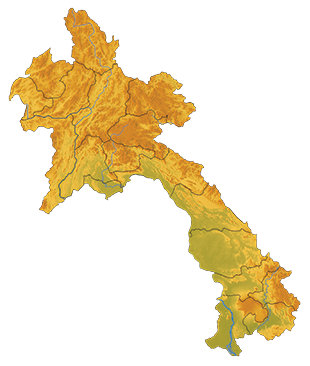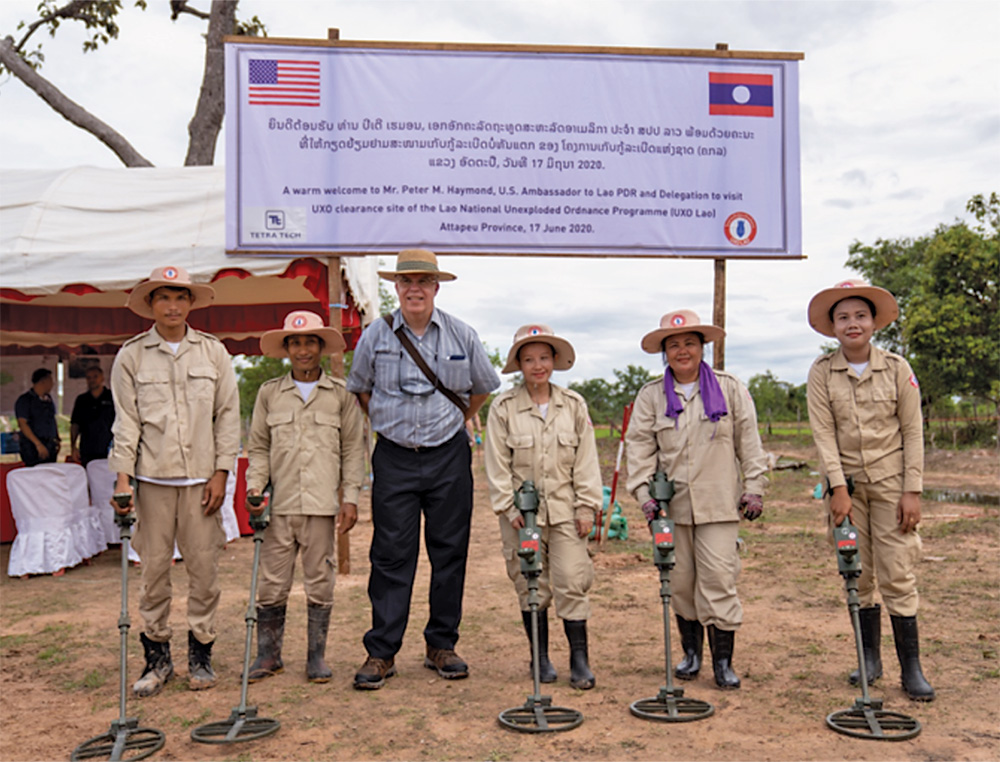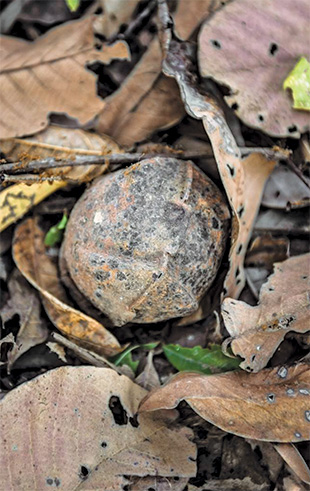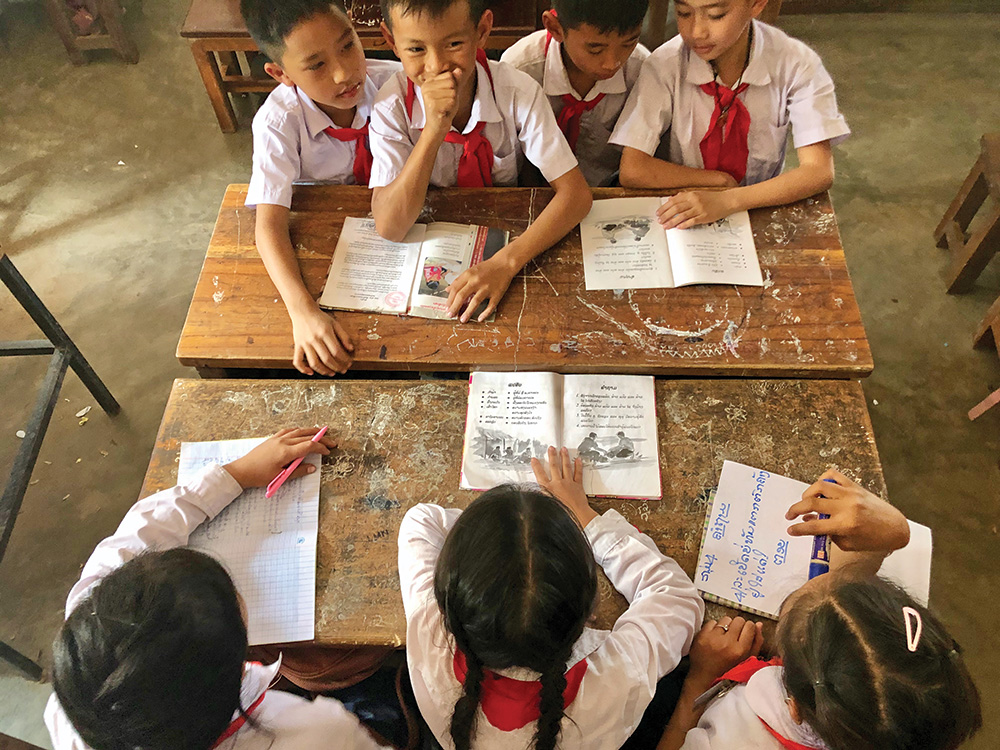Dealing with Hidden Danger
Capacity Development of Lao PDR’s Unexploded Ordnance Sector
CISR JournalThis article is brought to you by the Center for International Stabilization and Recovery (CISR) from issue 28.3 of The Journal of Conventional Weapons Destruction available on the JMU Scholarly Commons and Issuu.com.
By Kiengkay Ounmany, PhD [ Southeast Asian Ministers of Education Organization Regional Centre for Community Education Development ]
Lao People’s Democratic Republic (Lao PDR) suffered from the heaviest bombing in its history during the Second Indochina War (1955–1975). Two decades after the war, the Lao National Unexploded Ordnance Clearance Programme (UXO Lao) was established with financial and technical assistance from United Nations (UN) agencies and donor countries. The development of Lao PDR’s national UXO clearance capacity has been within the framework of multilateral and bilateral cooperation. The Lao PDR government is prepared to take ownership of the program, but additional capacity development is essential in the areas of strategic planning and funding mobilization if it is to meet the needs of its citizens who continue to live in the most heavily bombed country in the world per capita.1 This article examines how Lao PDR’s UXO sector has developed its capacity over the past three decades and identifies areas for further capacity development: strategic planning, financial and information management, and humanitarian mine action (HMA) quality management.

Introduction
Over two million tons of ordnance were dropped on Lao PDR territory during approximately 500,000 bombing missions by the US Airforce and its allies between 1964 and 1973.2 After the proclamation of Lao PDR on 2 December 1975, the country struggled to reconstruct its nation amid this legacy of war. The National Regulatory Authority for UXO/Mine Action (NRA) in Lao PDR reports that over 50,000 casualties have occurred since 1964 from UXO accidents. Between 2011 and 2020, UXO injured 356 and killed 106 people; over 50 percent of the victims being adolescents and children.3 Additionally, UXO constitutes a major barrier for socio-economic development. Consequently, UXO clearance was uniquely designated as Sustainable Development Goal 18 “Life Safe from UXO” for Lao PDR.4 In the early 1990s, international nongovernmental organizations (INGOs) initiated efforts to address UXO remaining from the war. The United Nations Development Programme (UNDP) assisted the Lao government in establishing the Lao National Unexploded Ordnance Program through the creation of the Laos UXO Trust Fund.5 International humanitarian UXO clearance operators then followed suit and initiated their own UXO clearance programs. Since the 1990s, Lao PDR’s national capacity has significantly strengthened through financial and technical support from UN agencies and donor countries. With limited data or continuous assessment of national capacity, measuring the contribution of each actor in the sector’s development is challenging.
Capacity Development of the Lao UXO Sector
Enabling Lao PDR’s UXO environment. Since economic liberalization in 1986, UNDP has assisted the Lao PDR government in the organization of the Round Table Process, which includes the Mine Action and UXO Sector Working Group chaired by the Ministry of Foreign Affairs. UNDP and the US Embassy in Vientiane also co-chair the Mine Action and UXO Sector Working Group, as the United States is the largest donor to the Lao UXO sector.6,7
Since the 1990s, UNDP has played an important role in the development of the Lao UXO sector by mobilizing funds from donors. Between 2017–2021, UNDP managed over US$12 million in contributions from Australia, the European Union, Ireland, Luxembourg, New Zealand, and the Republic of Korea.8 Many donor countries do not have embassies or representative offices in Lao PDR, which makes it difficult for them to monitor the implementation of projects they have funded. UNDP, therefore, plays an intermediary role in the transfer and monitoring of the use of donors’ funds in the Lao UXO sector.
Over the last five years, funding specifically into UNDP-managed funds has declined, partly because many donors send funds directly to international UXO clearance operators.9,10 Some donors stopped contributing funds, fatigued from the time and money they had already spent supporting the sector. Ultimately though, inaccurate data on the extent of UXO contamination across Lao PDR meant that donors were not sure when the UXO would be completely removed, making it difficult to justify their support.11 UXO Lao and the NRA rely on bombing data and the results of the Cluster Munition Remnant Survey in six heavily contaminated provinces for planning UXO clearance but do not take into account the huge number of ground-launched mines and ammunition (rifle grenades, mortars, rockets, etc.) that are also spread across the country. A cross-country contamination survey to determine the precise contamination areas of UXO and other explosive remnants of war would benefit the NRA. This would lead to better allocation of limited resources and increase clearance efficiency. And by evaluating the impact of UXO clearance on local livelihoods, donors could have evidence on the impacts of their assistance.
However, a number of administrative hurdles, such as import regulations and a long memorandum of understanding approval process, have diminished the UXO sector’s efficiency. The hectic import regulations have sometimes precipitated the shipment of UXO clearance equipment back to its country of origin.12 At other times, international UXO clearance operators have had to wait over six months for governmental approval prior to commencing their operations.13 By addressing these issues, the NRA Board could draw more support from international donors and accelerate UXO clearance.

Organizational level. The NRA, UXO Lao, and the Lao People’s Army Unit 58 are key government organizations working on UXO survey and clearance in Lao PDR. The following section discusses capacity development support they received from UNDP and Japan International Cooperation Agency (JICA), Korea International Cooperation Agency (KOICA), the United States, international UXO clearance operators, and other partners.
An outstanding support is the formulation of the National Strategic Plan for the Lao UXO Sector, simply known as Safe Path Forward.14 UNDP also provides programmatic support to the NRA and UXO Lao, including financial management and procurement, reporting and communication, data management and analysis, and strategic planning and coordination. In 2004, the Lao government established the NRA with the aim to improve planning, coordination, and regulation of the whole Lao UXO sector and was operational in 2006 under the Ministry of Labor and Social Welfare. As of September 2023, the NRA is now under the Ministry of Foreign Affairs. Representatives from eleven government ministries sit on the NRA’s board, which has consequently fostered stronger commitment from the government toward the sector.15 The board facilitates coordination among government agencies and relevant actors, including UXO clearance related INGOs and civil society organizations at different levels. The NRA is financially autonomous from the Lao government, as over 90 percent of the NRA’s operational budget is derived from donors through UNDP and other bilateral donors, allowing for more flexibility and transparency in its financial management.16 The Lao government contributes to the NRA through sub-regional offices called Provincial Regulatory Authority (PRA), which are in nine highly contaminated provinces across Lao PDR. The government provides support to the PRA’s personnel and budget, but some PRA staff have urged the government to provide more financial support for coordinating and monitoring of UXO clearance activities. The difference in financial compensation and government support between the sub-regional offices risks decreasing the efficiency in the coordination of the UXO sector at the provincial level.
The Lao government supports HMA activities in multiple ways. For instance, the Lao People’s Army operates a humanitarian UXO clearance team called Unit 58 that consists of seven teams of eight deminers, a medic, and a driver in each team. Unit 58 was established in 2013 with support from the UNDP and the KOICA and became operational in 2017.17 In 2021, Unit 58 began to build an additional thirteen teams to meet increasing demand for clearance with support from the UNDP and KOICA. However, Unit 58 still relies heavily on international support for capacity development, with only some support provided by the Lao government. Between 2022 and 2026, KOICA allocated US$11 million to the Lao UXO sector. A significant portion of the funding is spent for capacity development of Unit 58, while the Lao government provided US$100,000 for Unit 58 to work in Xaysomboun from 2019 to 2021. As part of a broader transition to national ownership, to ensure sustainability of the Lao UXO sector, the Lao government has allocated a plot of land to the unit since 2020 and plans to build an office and a training center in Vientiane. The monitoring and evaluation of the unit is conducted by an independent agency to ensure quality control. As such, while Unit 58 is a part of the Lao People’s Army, the unit’s operations are based on Lao’s National Mine Action Standards (NMAS) and their clearance is certified by the NRA.
The NMAS, which are based on the International Mine Action Standards (IMAS), were completed in 2012 through an inclusive process led by the NRA with support from the UNDP and other stakeholders. However, the NMAS are outdated because of changes in methodology (evidence-based survey) and technology (e.g., more farmers use larger tractors, which require deeper UXO clearance). There is a pressing need to update the NMAS to meet the requirements of development partners. The existing NMAS requires the default depth of UXO clearance to be 25 centimeters, while some development projects operating in Lao PDR require UXO clearance to be over 100 centimeters in depth. The NRA has tried to update the NMAS through hiring international experts, with support from the New Zealand government via the UNDP in October 2021. However, updating the 2012 NMAS has not progressed due to the impacts of the COVID-19 pandemic and uncertainty of funding from donor countries.18 In 2023, Norwegian People’s Aid (NPA) supported the NRA to review the National Standards on Information Management (chapter 24) through workshops and discussion involving all stakeholders. In 2024, the NRA office plans to review the other chapters of the National Standards based on the same standard development process. Also in 2024, the NRA office plans to establish a Technical Committee for the review of the National Standards.

Commercial companies such as Tetra Tech have played key roles in the development of Lao PDR’s UXO sector. Following US$90 million in aid from the United States following former President Obama’s visit to Lao PDR in September 2016, Tetra Tech was selected to oversee funding to UXO Lao and provide technical advisory support.19,20 In 2021, Tetra Tech employed ten full-time staff who provided assistance to UXO Lao on UXO survey and clearance, quality and information management, logistics and procurement, and finance at both the capital and provincial levels. Tetra Tech also supported the NRA with prioritization, explosive ordnance disposal (EOD) expert training, and information management.
Other partners have worked to support UXO Lao and the NRA. For example, JICA funded two experts to assist UXO Lao in computerized asset management, human resource management, and coordination between national and provincial levels.21 Additionally, NPA assisted the NRA in information management, particularly by upgrading Lao’s Information Management System for Mine Action (IMSMA). These capacity development activities, however, have been concentrated at the capital level, whereas the activities at the provincial and district levels are limited. Most UXO clearance activity occurs at the local level. As such, additional capacity development efforts should be promoted at the provincial and district levels through more financial and technical support. To contribute to this, NPA is supporting the NRA national office to provide information management training to provincial and district regulatory authorities in nine provinces.

Since the establishment of HMA in Indochina in the 1990s, there have been multiple efforts to promote collaboration in the region. JICA supported exchanges between UXO Lao and the Cambodia Mine Action Centre (CMAC) on operation, quality management, and human resource management. In 2021, JICA appointed technical advisors to CMAC. These exchanges between UXO Lao and CMAC have benefited both sides in management and technology. In demining quality management, for example, the NRA staff referred to CMAC’s experience in strengthening the NRA’s capacity in this area and consequently additional collaboration between UXO Lao and CMAC should be promoted.
There are still crucial areas where the Lao UXO sector needs to develop its capacity. A key example is in data management and analysis. The NRA and UXO Lao have collected large amounts of data, particularly from IMSMA. However, UXO operations have made limited use of data for analysis, planning, and decision-making. Some of the data that has been collected and used in operations has been inaccurate as some staff members within the provincial teams have limited digital literacy and use handwritten forms to report data to the NRA headquarters. In 2021, NPA aided the NRA’s upgrade to the UXO sector’s information management system to include Esri’s Geographic Information System through an NPA project. By doing so, UXO operators can now see information—such as confirmed hazardous areas—in real time, which has helped to increase the efficiency and effectiveness of their clearance operations. Further capacity development in data management and analysis, as well as digital upgrades, will enable the NRA and UXO Lao to improve their performance further.
Individual level. In 2022, the Lao UXO sector employed over 4,700 personnel, the majority of whom are local staff.22 Since the 1990s, the NRA and UXO Lao staff have undertaken training on planning, leadership, information management, and risk education in order to develop a national UXO clearance program. However, most of the UXO sector’s resources have been allocated to survey and clearance, while less are available for individual capacity development. Consequently, much of UXO Lao’s senior staff, with over twenty years of experience, are quickly approaching retirement age with few plans to develop future senior management in the Lao UXO sector.23 Without a human resource development plan for Lao’s UXO sector, the NRA risks losing leadership and strategic management expertise among senior NRA and UXO Lao staff. With the NRA taking the lead, UNDP and other development partners could provide funding and technical assistance. An initial assessment of the NRA and UXO Lao’s existing capacity would identify where these organizations should prioritize development. Partnerships with local institutions should be promoted by involving local academic institutions in providing training.
International UXO clearance operators have built their own training facilities and provided on-the-job training for their staff. These international organizations have also integrated UXO survivors and ethnic minorities into their workforce, with a large number of women as deminers, team leaders, and EOD experts.24 The inclusion of women and other marginalized groups helps to improve the capacity of individual UXO operations and increase efficiency of the UXO sector as a whole; for example, women deminers possess advantages when delivering risk education. As most of these women have experiences caring for vulnerable groups including children, elderly, and UXO survivors, they are likely to be more efficient in delivering risk education compared to their male counterparts. The inclusion of women in mine action efforts also conforms with the UN’s Gender Mainstreaming in Mine Action Framework, which has the goal to “provide practical steps to mainstream gender and promote gender equality in mine action programmes…”25 Employing local populations helps UXO clearance operators work more efficiently as citizens have greater understanding of the local languages, culture, and the environment, which helps operators liaise with local communities and identify UXO contamination areas.

Conclusion
Since the establishment of the UXO sector in the 1990s, the Lao government has worked with UNDP to foster a favorable environment that attracts support from bilateral and multilateral donors. However, it has been difficult for international donors who provide funds to UNDP to justify their support as there is little consolidated evidence on the impact of the different clearance efforts that have occurred over the years. Consequently, there has been a decline in international contributions from some donors, but not all, to UNDP-managed funds, which are mainly spent to support the key national agencies including the NRA and UXO Lao.26,27 While UNDP and development partners have contributed significantly to the increased capacity of key government institutions, such as the NRA and UXO Lao, a large proportion of these resources have been allocated for survey and clearance. As such, little funding was available for human resource development. Without this external support, the NRA and UXO Lao have struggled to establish and maintain high quality human resources. If the Lao UXO sector was able to develop additional capacity in information management, human resource management, and fund mobilization, the efficiency of the sector would improve significantly. This could contribute to Lao PDR achieving development goals and sustaining its UXO sector, reducing the impact of UXO on the people of Lao PDR.
See endnotes below.
 Kiengkay Ounmany, PhD, is the Deputy Director of the South East Asian Minister of Education Organization Regional Centre for Community Education Development. He received a PhD in Social and Economic Sciences from the University of Natural Resources and Life Science, Vienna, Austria, and is currently teaching development theories in a Master of International Development Studies Programme at the National University of Laos. A strong advocate for sustainable development, Dr. Ounmany involves his students in research on rural development, poverty reduction, and sustainable development in Lao PDR. His professional interests focus on rural development, participatory approach, human capital, and sustainable development. His key publications include “The Legacy of the Vietnam War: Making a Living amid Unexploded Ordnance in Xieng Khouang Province, Northern Laos” and “Impacts of Unexploded Ordnance Clearance on Wet Rice Farming in Xieng Khouang Province, Northern Laos.”
Kiengkay Ounmany, PhD, is the Deputy Director of the South East Asian Minister of Education Organization Regional Centre for Community Education Development. He received a PhD in Social and Economic Sciences from the University of Natural Resources and Life Science, Vienna, Austria, and is currently teaching development theories in a Master of International Development Studies Programme at the National University of Laos. A strong advocate for sustainable development, Dr. Ounmany involves his students in research on rural development, poverty reduction, and sustainable development in Lao PDR. His professional interests focus on rural development, participatory approach, human capital, and sustainable development. His key publications include “The Legacy of the Vietnam War: Making a Living amid Unexploded Ordnance in Xieng Khouang Province, Northern Laos” and “Impacts of Unexploded Ordnance Clearance on Wet Rice Farming in Xieng Khouang Province, Northern Laos.”

